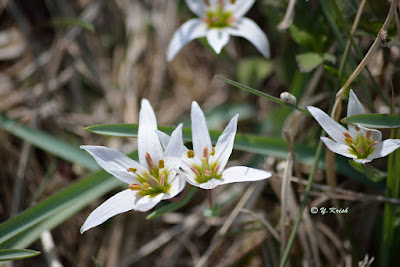Wild Life
Wild grass
Small flowers in spring
アマナ, Amana, Amana Edulis
ミドリハコベ, Midorihakobe, Chickweed
コハコベ, Kohakobe, Common Chickweed
ウシハコベ, Ushihakobe, Giant Chickweed
オランダミミナグサ, Orandamiminagusa, Sticky Chickweed
“Orandamiminagusa” was introduced from Europe. It grows everywhere on the ground.
No one pays attention to this grass without weeding them.
ナズナ, Nazuna, Shepherd’s Purse
“Nazuna” is also one of the seven herbs of spring. The hight is about 30 cm, and a flower is about 2 mm in diameter. The seeds are enclosed in a heart-shaped covering. Both of flower and seeds coat are pretty.
タネツケバナ, Tanetsukebana, Bitter Cress
オランダガラシ, Orandagarashi, Watercress
スノーフレーク, Summer Snowflake
バイモ, Baimo, Fritillaria Verticillata var. Thunbergii
ドクダミ, Dokudami, Fish Herb
カラスビシャク, Karasubisyaku, Crowdipper
タチツボスミレ, 立壺菫, Tachitsubo-sumire, Viola Grypoceras
We mostly find “Tachitsubo-sumire” in the sunny field. It is a typical “Sumire” in Japan.
ノジスミレ, Noji-sumire, Viola Yedoensis
“Noji-sumire” becomes to bloom at the beginning of March. A slender leaf is a peculiarity of "Noji-sumire".
アメリカスミレサイシン, Amerika-sumiresaishin, Common Blue Violet
ノビル, Nobiru, Long-stamen Chive
フデリンドウ, Fuderindo, Gentiana Zolingeri
サクラソウ, Sakuraso, Primrose
ハナダイコン, Hanadaikon, Dame’s Rocket
ヤハズエンドウ, Yahazuendo, Narrow-leaved Vetch
ムラサキサギゴケ, Murasakisagigoke, Mazus Miquelii
オオイヌノフグリ, Ooinunofuguri, Bird-eye Speedwell
フラサバソウ, Furasabaso, Ivy-leaved Speedwell
ハナイバナ, Hanaibana, Bothriospermum Tenellum
“Hanaibana” grows from spring to autumn. A flower is about 2 mm in diameter.
ヒメオドリコソウ, Himeodorikoso, Red Dead-nettle
ホトケノザ, Hotokenoza, Common Henbit
ムラサキケマン, Murasakikeman, Corydalis Incisa
カキドウシ, Kakidoushi, Alehoof
レンゲソウ, Rengeso, Chinese Milk Vetch
タツナミソウ, Tatsunamiso, Scutellaria Indica
ハナヤエムグラ, Hanayaemugura, Sherardia
ムラサキスズメノオゴケ, Murasakisuzumenoogoke, Vincetoxicum x Purpurascens
ユウゲショウ, Yugesyo, Rose Evening Primrose
アカツメクサ, Akatsumekusa, Red Clover
ノアザミ, Noazami, Japanese Thistle
キツネアザミ, Kitsuneazami, Hemisteptia Lyrata Bunge
コヒルガオ, Kohirugao, Calystegia Hederacea
ナガミヒナゲシ, Nagamihinageshi, Long-headed Poppy
クサボケ, Kusaboke, Japanese Quince
ヘビイチゴ, Hebiichigo, Potentilla Hebiichigo
オヘビイチゴ, Ohebiichigo, Potentilla Anemonifolia
イワニガナ, Iwanigana, Ixeris Stolonifera
ブタナ, Butana, Cats Ear
ニガナ, Nigana, Toothed Ixeridium
オニタビラコ, Onitabirako, Oriental False Hawksbeard
ノゲシ, Nogeshi, Common Snow-thistle
ノボロギク, Noborogiku, Groundsel
タンポポ, Tanpopo, Dandelion
シロバナタンポポ, Shirobana-tanpopo, White-flowering Dandelion
キバナツノウマゴヤシ, Kibanatsunoumagoyashi, Ornithopus Compressus
キツネノボタン, Kitsunenobotan, Ranunculus Silerifolius
タガラシ, Tagarashi, Celery-leaved Buttercup
スカシタゴボウ, Sukashitagobo, Bog Yellowcress
トウダイグサ, Toudaigusa, Sun Spurge
キリンソウ, Kirinso, Sedum Aizoon
“Kirinso” grows in the grassland. Many yellow flowers bloom on the top of a stem. The hight is about 20 cm.
クサノオウ, Kusanoo, Greater Celandine
“Kusanoo” grows in the shady grassland. It contains about 20 kinds of alkaloid, so it is a highly poisonous plant. The hight is about 50 cm.
We don’t have much snow in Kanto region, so the wild flowers begin to bloom from January. They mostly bloom all together, and various flower colors decorate the sunny field. Then the cherry blossoms cover the air light pink in April.
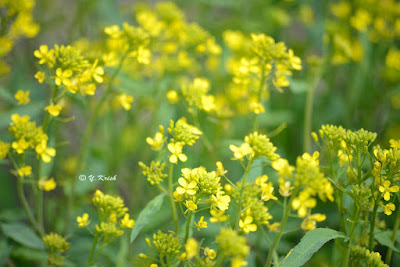 |
| "Nanohana" |
* Plant's name is described in order of Japanese name (Kana), description of Roman alphabet, and English name (or Scientific name).
ハルジオン, Harujion, Philadelphia Fleabane
“Harujion” was introduced from North America. The hight of this grass is about 60 cm. It grows in the footpath between rice field, the roadside or the sunny field. The fragile looks of flowers are in harmony with a mild climate.
 |
| "Harujion" |
アマナ, Amana, Amana Edulis
“Amana” blooms at the beginning of April in the sunny field. A flower-stalk goes through the thick grass. The length of flower-stalk is about 15 cm. It blooms few days and disappear into the thick grass, so it is called as a Spring Ephemeral.
アメリカフウロ, Amerikafuuro, Carolina Geranium
“Amerikafuuro” was introduced from North America. A flower of “Amerikafuuro” looks like “Gennosyoko”; Thunberg’s Geranium. The grass hight is about 30 cm. This grass is a prolific plant, and I can see it every fields in Kashiwa.
 |
| "Amerikafuuro" |
ミドリハコベ, Midorihakobe, Chickweed
“Midorihakobe” is one of the seven herbs of spring. It is a native species. The hight is about 20 cm. It produces small flowers with five white flower-petals.
 |
| "Midorihakobe" |
コハコベ, Kohakobe, Common Chickweed
“Kohakobe” grow in colonies in the shady place. It was introduced from Europe, but we don’t know when this grass was introduced. We generally identify both of “Midorihakobe” and “Kohakobe” as just “Hakobe”. But each of them naturally keeps their habitat by adapting to the environment.
 |
| "Kohakobe" |
ウシハコベ, Ushihakobe, Giant Chickweed
“Ushihakobe” grows bigger than “Midorihakobe”. The hight is about 40 cm. There are 5 flower petals, and it looks like 10 because each petal is split into two. “Ushihakobe” is considered as separate genus from other chickweeds.
| "Ushihakobe" |
オランダミミナグサ, Orandamiminagusa, Sticky Chickweed
“Orandamiminagusa” was introduced from Europe. It grows everywhere on the ground.
No one pays attention to this grass without weeding them.
 |
| "Orandamiminagusa" |
ナズナ, Nazuna, Shepherd’s Purse
“Nazuna” is also one of the seven herbs of spring. The hight is about 30 cm, and a flower is about 2 mm in diameter. The seeds are enclosed in a heart-shaped covering. Both of flower and seeds coat are pretty.
 |
| "Nazuna" |
タネツケバナ, Tanetsukebana, Bitter Cress
“Tanetsukebana” mostly grows in the footpath between rice field. The hight is about 20 cm. A flower looks like that of “Nazuna”, but the shape of leaf is different.
ヒメウズ, Himeuzu, Semiaquilegia Adoxoides
“Himeuzu” blooms from autumn through spring in the shiny slope. A flower is about 6 mm in length, and it is not noticeable.
 |
| "Himeuzu" |
カナビキソウ, Kanabikiso, Thesium Chinense
“Kanabikiso” grows on the sunny field. It blooms small white flowers ( about 3 mm ) from April to May. This grass is a semi-parasitic plant.
| "Kanabikiso" |
オランダガラシ, Orandagarashi, Watercress
“Orandagarashi” was introduced from Europe. It grows in the stream of spring water.
The temperature of spring water is constant throughout the year, so “Orandagarashi” survive in a cold climate. But it seems to be sensitive to the heat and disappears with the coming of summer.
 |
| "Orandagarashi" |
スノーフレーク, Summer Snowflake
Snowflake was introduced from Europe as an ornamental plant. A flower looks like that of Snowdrop. I found it in the sunny dike near “Tonegawa” river.
 |
| Snowflake |
シロツメクサ, Shirotsumekusa, White Clover
“Shirotsumekusa” was introduced from Europe for the forage. They grow in colonies all places of sunny field, so it is one of the familiar grass for Japanese people.
 |
| "Shirotsumekusa" |
バイモ, Baimo, Fritillaria Verticillata var. Thunbergii
“Baimo” was introduced from China. It is a medicinal herb. A downcast flower and quiet colors make it as a plain grass.
 |
| "Baimo" |
ドクダミ, Dokudami, Fish Herb
“Dokudami” grow in colonies in the shady place. It is used for herb tea in Japan. It has four white bracts, and a yellow spike is in the center of bracts. This spike is an aggregate of small flowers.
 |
| "Dokudami" |
スイカズラ, Suikazura, Japanese Honeysuckle
“Suikazura” is a climbing plant. The flowers are white, fragrant and elegant. It doesn’t look like that and grows strong on the bush. This is also a medical herb.
 |
| "Suikazura" |
カラスビシャク, Karasubisyaku, Crowdipper
“Karasubisyaku” grows on the road side of rice field. It blooms a brownish green inconspicuous flower. This grass was introduced from China in ancient times.
| "Karasubisyaku" |
スミレ, Sumire, Violet
We can see various kinds of "Sumire" in Japan. And we generally call any kinds of Violet as “Sumire”. We feel the arrival of spring when we find “Sumire” in the field.
マルバスミレ, Maruba-sumire, Viola Keiskei
“Marubasumire” grow in colonies in the shady slope. A flower is white, and a leaf is round.  |
| "Maruba-sumire" |
タチツボスミレ, 立壺菫, Tachitsubo-sumire, Viola Grypoceras
We mostly find “Tachitsubo-sumire” in the sunny field. It is a typical “Sumire” in Japan.
 |
| "Tachitsubo-sumire" |
ノジスミレ, Noji-sumire, Viola Yedoensis
“Noji-sumire” becomes to bloom at the beginning of March. A slender leaf is a peculiarity of "Noji-sumire".
 |
| "Noji-sumire" |
アリアケスミレ, Ariake-sumire, Viola Betonicifolia var. Albescens
“Ariake-sumire” grows on the sunny field. The flower stem of this viola is about 10 cm in length. “Ariake-sumire” is one of the most widely distributed violets in Japan.
| "Ariake-sumire" |
アメリカスミレサイシン, Amerika-sumiresaishin, Common Blue Violet
“Amerika-sumiresaishin” was introduced from North America as a garden plant.
A flower is bigger, and the color of flower is more dark than other “Sumire”.
 |
| "Amerika-sumiresaishin" |
ノビル, Nobiru, Long-stamen Chive
“Nobiru” grows from autumn through spring, and it blooms small flowers on the top of flower-stalk in late spring. The length of flower-stalk is about 60 cm.
 |
| "Nobiru" |
フデリンドウ, Fuderindo, Gentiana Zolingeri
“Fuderindo” blooms several flowers on the top of stem. A well-proportioned flower is pretty. It grows in the sunny field.
| "Fuderindo" |
サクラソウ, Sakuraso, Primrose
“Sakuraso” grows in the wetlands. The native “Sakuraso” is rare, and the wild species is designated as an endangered species. I found several “Sakuraso” at Kashiwa Village waterside-park in the middle of March.
| "Sakuraso" |
アケビ, Akebi, Chocolate Vine
“Akebi” is a climbing plant. It blooms light purple flowers early in spring.
| "Akebi" |
“Hanadaikon” was introduced from Europe as an ornamental plant. It grows in the sunny field. The hight is about 80 cm.
 |
| "Hanadaikon" |
ヤハズエンドウ, Yahazuendo, Narrow-leaved Vetch
“Yahazuendo” was introduced from Europe. It grows in the sunny field. It has a strong ability to survive, so we can see it everywhere all the year round in Kanto region.
 |
| "Yahazuendo" |
ムラサキサギゴケ, Murasakisagigoke, Mazus Miquelii
“Murasakisagigoke” grows in the wet land. The hight is about 5 cm. It propagate by runners. Sometimes, they cover the ground like a carpet in April.
 |
| "Murasakisagigoke" |
オオイヌノフグリ, Ooinunofuguri, Bird-eye Speedwell
“Ooinunofuguri” was introduced from Europe. It blooms all the year round in Kashiwa, but it grows vividly in spring.
 |
| "Ooinunofuguri" |
フラサバソウ, Furasabaso, Ivy-leaved Speedwell
“Furasabaso” was introduced from Europe. It grows in the shady place. A flower is about 3 mm in diameter, and It is unremarkable grass.
 |
| "Furasabaso" |
ハナイバナ, Hanaibana, Bothriospermum Tenellum
“Hanaibana” grows from spring to autumn. A flower is about 2 mm in diameter.
 |
| "Hanaibana" |
ヒメオドリコソウ, Himeodorikoso, Red Dead-nettle
“Himeodorikoso” was introduced from Europe. Small flowers bloom between the leaves. The leaves grow alternately, so it looks like to wear a straw raincoat.
 |
| "Himeodorikoso" |
ホトケノザ, Hotokenoza, Common Henbit
“Hotokenoza” blooms all the year round. It is one of the seven herbs of spring. Needless to say, they grow vividly in spring.
 |
| "Hotokenoza" |
ムラサキケマン, Murasakikeman, Corydalis Incisa
“Murasakikeman” blooms several tubular flowers on the top of flower-stalk. It is a poisonous plant.
 |
| "Murasakikeman" |
カキドウシ, Kakidoushi, Alehoof
“Kakidoushi” grows by the roadside. It is a medicinal herb, and a leaf gives a fragrance when it is crumpled.
ニワゼキショウ, Niwazekisyo, Annual Blue Eyed Grass
“Niwazekisyo” was introduced from North America as an ornamental plant.
It strongly grows among other “Zasso”; Weeds in the sunny field.
 |
| "Niwazekisyo" |
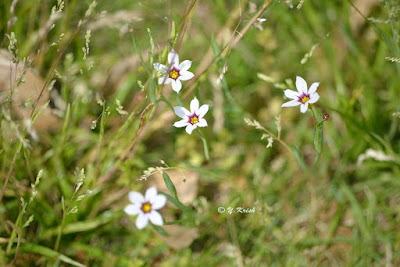 |
| White color |
レンゲソウ, Rengeso, Chinese Milk Vetch
“Rengeso” was introduced from China. Sometimes it is used as a green manure for the rice field. Wild “Rengeso” grows by the sunny farm road.
 |
| "Rengeso" |
タツナミソウ, Tatsunamiso, Scutellaria Indica
“Tatsunamiso” grow in colonies. It expands a habitat by extending the underground stem. But it is not easy to expand a habitat under the environment of severe grass-to-grass competition. The hight is about 25 cm.
 |
| "Tatsunamiso" |
ハナヤエムグラ, Hanayaemugura, Sherardia
“Hanayaemugura” was introduced from Europe. The hight is about 35 cm, and a tiny flower is about 3 mm in diameter. We don’t find this grass without careful observation.
ノヂシャ, Nojisya, Lamb’s Lettuce
“Nojisya” was introduced from Europe. I heard it is an edible plant in Europe, but we know the seven herbs of spring or edible wild plants in Japan, so we don’t care about “Nojisya” as an edible plant.
ヤセウツボ, Yaseutsubo, Common Broomrape
“Yaseutsubo” was introduced from Europ. It is a parasitic plant, so it has no leaf.
It parasites on the grass belonged to the legume plant. It grows in the sunny field.
 |
| "Yaseutsubo" |
ムラサキスズメノオゴケ, Murasakisuzumenoogoke, Vincetoxicum x Purpurascens
“Murasakisuzumenoogoke” grows in the sunny field. The hight is about 50 cm.
It blooms many dark-red flowers on the stem. A fragrance of flower probably fascinates many kinds of flies (not honey bees).
 |
| "Murasakisuzumenoogoke" |
ユウゲショウ, Yugesyo, Rose Evening Primrose
“Yugesyo” was introduced from North America as an ornamental plant, and it grows in the west of Kanto region. It blooms from spring through autumn.
 |
| "Yugesyo" |
アカツメクサ, Akatsumekusa, Red Clover
“Akatsumekusa” was introduced from Europe for the forage. The hight is about 40 cm.
 |
| "Akatsumekusa" |
ノアザミ, Noazami, Japanese Thistle
“Noazami” grows in the sunny field. The hight is about 70 cm. A head inflorescence is composed of many tubler flowers. A leaf has pickles.
 |
| "Noazami" |
キツネアザミ, Kitsuneazami, Hemisteptia Lyrata Bunge
“Kitsuneazami” grows on the roadside of rice field. The hight of this grass is about 80 cm. This grass belongs to a different genus from thistle.
| "Kitsuneazami" |
コヒルガオ, Kohirugao, Calystegia Hederacea
“Kohirugao” grows on the roadside of paddy field. It blooms pink flowers from the end of spring to summer.
 |
| "Kohirugao" |
ナガミヒナゲシ, Nagamihinageshi, Long-headed Poppy
“Nagamihinageshi” was introduced from Europe. It grows in the farmland or shiny grassland. The hight is about 50 cm. It belongs to poppy family, but it doesn’t contain an alkaloid.
 |
| "Nagamihinageshi" |
クサボケ, Kusaboke, Japanese Quince
“Kusaboke” grows in the sunny field. It is a woody plant. In case of growing in the dike, they are cut at the right moment, so the hight is always short as with other wild grass.
 |
| "Kusaboke" |
ヘビイチゴ, Hebiichigo, Potentilla Hebiichigo
“Hebiichigo” grows in the wet grassland. It expands a habitat by extending stolons.
A fruit looks like strawberry (small size). It doesn’t contain a poison, but it tastes awful.
 |
| "Hebiichigo" |
オヘビイチゴ, Ohebiichigo, Potentilla Anemonifolia
“Ohebiichigo” grows in the wet grassland. The leaves are divided into five leaflets, and a flower-stalk is about 30 cm in length.
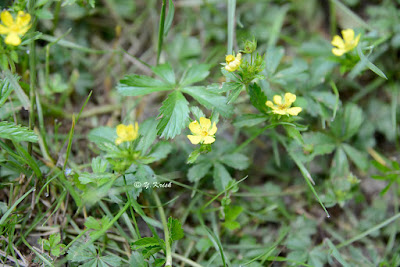 |
| "Ohebiichigo" |
イワニガナ, Iwanigana, Ixeris Stolonifera
“Iwanigana” grows in the sunny field. The hight is about 10 cm. It expands a habitat by extending stolons.
 |
| "Iwanigana" |
ブタナ, Butana, Cats Ear
“Butana” was introduced from Europe. It grows in the sunny field. The length of flower-stalk is about 50 cm.
 |
| "Butana" |
ニガナ, Nigana, Toothed Ixeridium
“Nigana” grows in the sunny field. A flower is about 15 mm in diameter.
コウゾリナ, Kouzorina, Picris Hieracioides
“Kouzorina” grows in the sunny field. It is indistinguishable from “Hananigana”.
 |
| "Kouzorina" |
オニタビラコ, Onitabirako, Oriental False Hawksbeard
“Onitabirako” grows by the farm road. A flower is about 8 mm in diameter.
 |
| "Onitabirako" |
ノゲシ, Nogeshi, Common Snow-thistle
“Nogeshi” was introduced from Europe. It grows in the grassland from spring through autumn. The hight is about 70 cm.
 |
| "Nogeshi" |
ノボロギク, Noborogiku, Groundsel
“Noborogiku” was introduced from Europe. The yellow florets are hidden by the bracts that giving the flowers an inconspicuous appearance. It grows anywhere of the barren land all the year round in Kanto region.
 |
| "Noborogiku" |
タンポポ, Tanpopo, Dandelion
“Tanpopo” is a typical spring grass. Several introduced species and a small kinds of native species grow in Japan.
 |
| "Tanpopo" |
シロバナタンポポ, Shirobana-tanpopo, White-flowering Dandelion
“Shirobana-tanpopo” is a native species. It is widely distributed in western Japan.
| "Shirobana-tanpopo" |
キバナツノウマゴヤシ, Kibanatsunoumagoyashi, Ornithopus Compressus
“Kibanatsunoumagoyashi” was introduced from Europe. It grows in the sunny field.
The hight is about 15 cm.
 |
| "Kibanatsunoumagoyashi" |
キツネノボタン, Kitsunenobotan, Ranunculus Silerifolius
“Kitsunenobotan” grows in the wet land. It is a poisonous plant. The hight is about 50 cm.
ウマノアシガタ, Umanoashigata, Japanese Buttercup
“Umanoashigata” grows in the sunny field. The hight is about 40 cm. It is also a poisonous plant.
| "Umanoashigata" |
タガラシ, Tagarashi, Celery-leaved Buttercup
“Tagarashi” grows in the paddy field. It blooms many small flowers, and produces oval-shaped fruit. It is the most toxic buttercup.
 |
| "Tagarashi" |
スカシタゴボウ, Sukashitagobo, Bog Yellowcress
“Sukashitagobo” grows in the ridge between rice field. The hight is about 40 cm.
It grows from spring to autumn.
 |
| "Sukashitagobo" |
ハハコグサ, 母子草, Hahakogusa, Jersey Cudweed
“Hahakogusa” is one of the grass to use during the Seven-Herbs Festival in spring. Many yellow florets bloom on the top of a flower-stalk.
 |
| "Hahakogusa" |
コメツブツメクサ, Kometsubutsumekusa, Suckling Clover
“Kometsubutsumekusa” was introduced from Europe. It grows by the roadside.
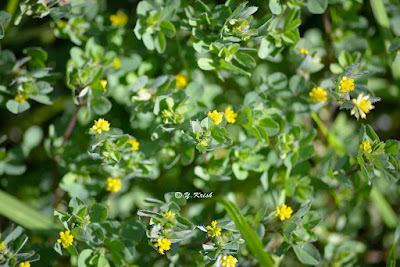 |
| "Kometsubutsumekusa" |
“Toudaigusa” grows in the grassland. I couldn't distinguish yellow-green flowers from light green leaves. It is a poisonous plant. The hight is about 20 cm.
 |
| "Toudaigusa" |
キリンソウ, Kirinso, Sedum Aizoon
“Kirinso” grows in the grassland. Many yellow flowers bloom on the top of a stem. The hight is about 20 cm.
 |
| "Kirinso" |
コモチマンネングサ, Komochimannengusa, Sedium Bulbiferum
“Komochimannengusa” grows in the grassland. The leaves and flowers are small, a flower is about 10 mm in diameter. |
| "Kogomemannengusa" |
クサノオウ, Kusanoo, Greater Celandine
“Kusanoo” grows in the shady grassland. It contains about 20 kinds of alkaloid, so it is a highly poisonous plant. The hight is about 50 cm.
 |
| "Kusanoou" |
References;
[1] Wikipedia
[2] Observation reference-book of wild flowers
野の花・山の花 観察図鑑; Publisher 「主婦の友社」
[3] Wild plants in all seasons ( 四季の山野草; http://www.ootk.net/shiki/ )
All Rights Reserved, Y. Krish Hiwatari
